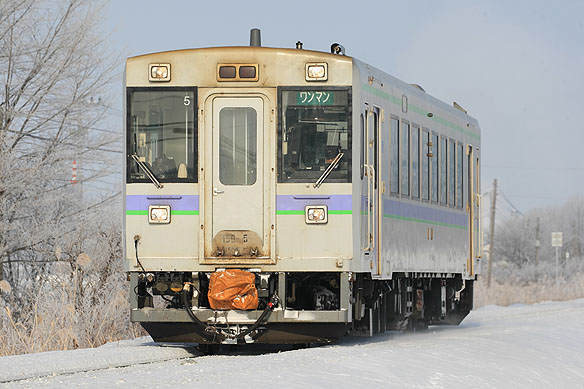Background and overview
JR Hokkaido developed class kiha150-0 single-car diesel multiple unit (DMU) train in order to replace superannuated class kiha22 and class kiha56 vehicles. 10 vehicles were built in 1993.
Car body
Bodies constructed by steel have 19500mm long and 2925.4mm wide body having
2 cabs at the ends of their body and mounting structure around gutters
and side beams of their underframe. Cab ends have a gangway. Two headlights
employing the rectangle sealed beam light bulb are fitted each side of
the gangway. Extra HID lamps are fitted above the windscreen and tail lamps
are above the gangway. A destination rollsign is fitted toward the upper
part of the cab side windscreen. They are equipped with two 988mm wide
stepped single leaf semi-automatic sliding doors which can be opened/closed
by pushing buttons beside the doors, and double-glazing fixed windows.
Loudspeakers providing guidance broadcast for passengers waiting at a station
and traditional destination rollsigns are fitted each side of the body.
They employ an air conditioner, N-AU150, rated at 20,600kcal/h, of which
indoor unit is fitted on their roof and of which outdoor unit is fitted
under their floor and driven by their prime mover. Four electric cross
flow fans supply fresh air into the passenger room, instead of ventilators
on the roof. The livery of the vehicles allocated at Asahikawa depot is
light gray with light purple and light green narrow bands below the windows
and with a light green narrow band above the windows. Doors are also painted
in light purple. On the other hand, the livery of the vehicles allocated
at Naebo depot is light gray with light green and sky-blue narrow bands
below the windows and with a sky-blue narrow band above the windows. Doors
are also painted in light green.
Bogies
Class kiha150-0 vehicles are equipped with N-DT150 for powered and N-TR150 for trailer featuring bolster-less secondary air suspension, rolled rubber spring journal supporting system having rods connected with the truck frame, and 2-axle drive. Their bogie employs bow-shaped bogie frame to lower the fitting position of bolster suspension due to fit under the stepped doors. Both powered and trailer bogies employ single tread brake device.
Traction unit and ancillary equipments
Class kiha150-0 vehicles are powered by a diesel prime mover, SA6D140-H, named N-KDMF15HZ by JR Hokkaido with a power output of 450PS, employing the supercharger and the intercooler to achieve higher power output. Their hydraulic transmission gear is N-DW14C employing multi-plate wet clutch and two-staged direct coupled range. They are equipped with a generator, TRP15-6, with a power output of 9kVA and an air compressor, C600, driven by the prime mover. Their brake system is the automatic electromagnetic (CLE) air brake with hydraulic retarder and holding brake provided by converter brake of their hydraulic transmission gear.
Accommodation
Seating is arranged as mixture of longitudinal bench seating located near the doorways and 2 or 4-seat transverse seating bays with 1490mm seating pitch located at the centre of the passenger cabin. Electric fans are fitted under the ceiling. They adopt sliding curtains. They are not vestibuled but partitioned. They adopt warm-air heater heated by the coolant water of the prime mover. A Japanese style toilet employing a chemical holding tank is located toward rear of the vehicle. They are equipped with the ticket machines to issue the ticket indicating the boarding station at the doorways, the fare box near the driver's seat and the fare display behind the cab for the conductor-less operation
Operations
10 Class kiha150-0 vehicles were delivered to Asahikawa depot and entered the revenue services on the Furano, Souya, and Sekihoku lines in 1993. Additional 7 vehicles were delivered to Naebo depot and enter the rural services of the Hakodate line between Oshamambe and Otaru in 1995. However, class kiha150-0 vehicles allocated at Naebo depot were displaced with class H100 DMU trains and reallocated to Asahikawa to enter the rural services on the Rumoi, Sekihoku, and Hakodate lines between Takigawa and Asahikawa in 2020.
Class kiha150-0 DMUs are now used on the rural services of the Furano, Rumoi, Sekihoku, and the partial Hakodate lines between Takigawa and Asahikawa. |
|

